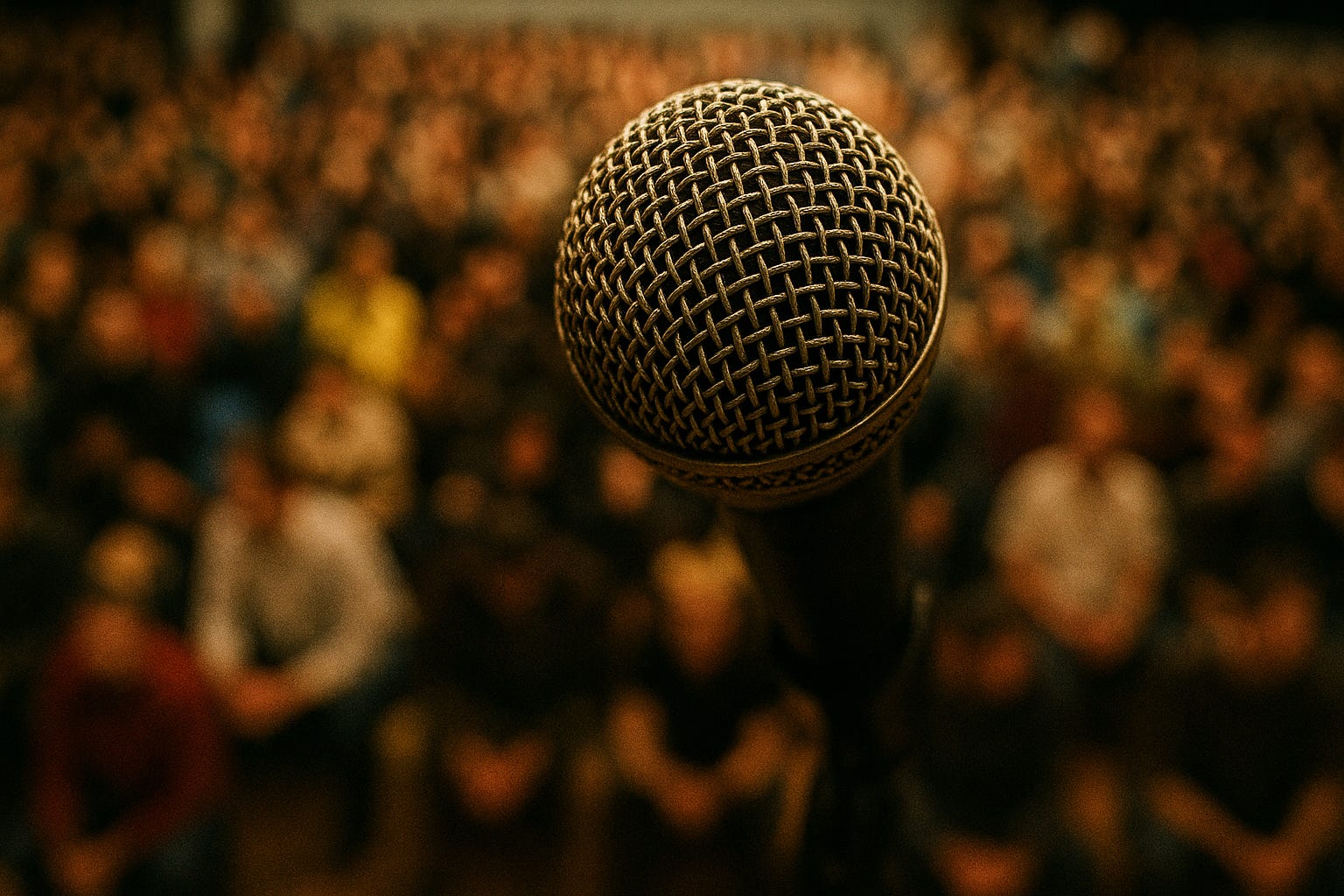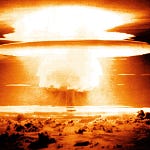Dear Permission to be Powerful Reader,
I don’t want to alarm you…
And, I don't want to upset any American.
Especially not right now.
But I think this is an important story to tell.
Not because I have a beef to pick with someone.
I think it puts into perspective the current times in ways that are absolutely terrifying.
The news is just waking up to the fact that Trump "might" be a dictator.
And we're all scratching our heads as to what might happen as innocent people are being human trafficked to foreign death camps.
But unfortunately... the US has a long history of war crimes.
We have an MO.
A pattern.
Past behavior is one of the best predictors of future behavior.
Not wishful thinking.
So, how are we likely to react as Trump's crimes escalate?
How did the US respond in the past?
The answers are terrifying.
With that said...
We go into Guantanamo Bay and Abu Ghraib.
The crimes.
Their disturbing nature.
Sadistic acts that shock the conscience.
How this was allowed and enabled.
How few people were held accountable.
How influential people were protected. (Rumsfeld wanted to resign twice over Abu Ghraib but Bush said no both times)
Explore why people did not stand up for justice. Those who did... and what this means for our Trump era.
And, beyond that, we know how we reacted to atrocities…
During FAR better times.
Among FAR better people.
The stars and stripes wave in broad daylight – a symbol of freedom and justice. But behind that proud banner lies a darker truth.
How Trump’s El Salvador prison looks like Abu Ghraib 2.0.
For decades, the United States has sanctioned brutal abuses in its name, from Abu Ghraib to Guantánamo Bay to the jungles of Vietnam, and to hidden drone strikes around the world.
These are not “mistakes” of rogue soldiers but systematic tactics authorized at the highest levels. Victims – children, old men, pregnant women – have died screaming, and their agony has been recorded and remembered.
Yet the architects and enablers of these horrors have faced no real justice. Instead, whistleblowers and war-weary soldiers have been punished, while powerful officials offered only silence or empty apologies.
This legacy of impunity is a stain on America’s soul that urgently demands to be acknowledged – because history shows that without reckoning, it can repeat itself.
Guantánamo Bay: The Forever Prison of Torture
Behind the prison bars, innocent eyes stare out like a trapped animal’s – the product of endless “if it saves a life” logic. Since 2002, the Cuban gulag of Guantánamo has held hundreds of detainees without charge or trial.
Many were swept up in the post‑9/11 dragnet simply for being in the wrong place at the wrong time, or tortured into false confessions. At Guantánamo (and in secret CIA “black sites” abroad), prisoners suffered waterboarding, sleep deprivation, mock executions, forced nudity, and worse.
Torture victim Abu Zubaydah was waterboarded 83 times; Khalid Sheikh Mohammed, alleged planner of 9/11…
At least 183 times.
Even Sen. John McCain – who himself had endured torture – warned that these methods produced no useful intelligence, only the stain of atrocity.
Today, almost 20 years on, 39 men remain locked up at Guantánamo – many never charged with any crime. Some suffer mental illness from abuse and isolation; at least ten have committed suicide or attempted to.
Meanwhile, dozens who should have been released (even by U.S. agreements) still rot in cells. Families search for missing sons, only to find they are locked indefinitely at Camp Delta.
The legal finger-pointing and military excuses cannot hide the reality: this prison is a living scar where the rule of law is discarded.
No senior official has ever been prosecuted for creating or endorsing this regime of torture and endless detention.
Even President Obama, elected on promises to shut down Guantánamo, left it open; President Biden also hesitated to close it. The U.S. claims to stand for freedom, yet at Guantánamo it denies freedom to the innocent and accountability to the guilty.
Abu Ghraib: Shame Photographed
“That was such a stain on our country,” said Defense Secretary Donald Rumsfeld when gruesome photographs emerged from Iraq’s Abu Ghraib prison in 2004.
He publicly lamented the abuses – tortured men in dog harnesses, inmates piled naked in pyramid poses, fingers threatening electric shocks, and forced sexual degradation.
Privates and sergeants grinned in the snapshots; victims like Ali Shallal al-Qaisi were left permanently maimed. Secret recordings and later interviews revealed Iraqis describing “being made to simulate sex, being raped with objects, threatened with dogs” – a catalogue of sadism that no official acknowledged was sanctioned.
When the scandal broke, Rumsfeld offered his resignation twice, only to be told by President Bush that he was an “important part of my cabinet” and must stay on.
In the end, the only people punished were low-level soldiers. Brigadier General Janis Karpinski – the camp commander – was demoted to colonel and mocked as the scapegoat, even as she insisted that “the orders came from the top,” implicating higher brass.
A few privates (like Lynndie England and Sabrina Harman) served short prison terms; Karpinski herself apologized to Iraqis and was ultimately pushed out of the Army.
Yet the civilian contractors and Pentagon lawyers who drew up torture manuals were untouched. The man at the top, President George W. Bush, never even spoke to many of the victims or publicly accepted blame – indeed, records reveal he later praised Rumsfeld for staying on after Abu Ghraib.
The net result: hundreds of Iraqi detainees suffered indignities and pain, but not a single U.S. official at the policy level was held accountable.
Vietnam’s My Lai and Legacy of Blood
“It was complete chaos and madness,” recalled one U.S. soldier. In March 1968, in the tiny village of My Lai, American troops killed between 300–500 unarmed Vietnamese civilians – women, children and elders. Infants were blasted from their cradles, screaming children machine-gunned, pregnant mothers bayoneted. A helicopter pilot on-scene, Hugh Thompson, and his crew actually drew weapons on U.S. soldiers to stop the killing; their bravery spared some lives.
But the slaughter was covered up by commanders for over a year. When the truth emerged, the only person convicted was Lt. William Calley – a young platoon leader who later admitted he gave the order “to start killing the civilians.” He was found guilty of 22 counts of murder and given life in prison, sparking a domestic uproar and a “Free Calley” campaign. His sentence was soon commuted; President Nixon gave him parole after only a few years.
Calley was made the scapegoat for a rotten war and a rotten policy, while every senior officer – commanders in Hanoi and Washington – escaped unpunished. Captain Ernest Medina and Colonel Oran Henderson, who led the units, were acquitted at trial. Even General William Westmoreland, the Army chief, publicly insisted, “Americans never massacred people deliberately”.
The lesson of My Lai was that American troops could commit mass murder and get away with it. It also cemented a perennial theme: those who decry war crimes (like Thompson or whistleblower Ron Ridenhour who leaked the story) were hounded or ignored. Yet their testimony helped change minds. After My Lai, a generation of Americans learned that “kill orders” from above could target innocents. It sparked intense protests and a rethinking of military honor.
Sadly, even that horrors’ corrective was temporary; new myths arose that the US “acted nobly.” But the corpses in the rice paddy proved otherwise. The shadow of My Lai still warns us that if leaders authorize killing without accountability, ordinary soldiers will kill ordinary people – and civilians pay the price.
Drone Warfare: Death from Afar
A tiny machine hums unseen in the dying sun – its payload invisible, its victims countless. In the 21st century, America’s battlefield has gone digital. Predator drones and missiles now strike villages in Pakistan, Afghanistan, Yemen and beyond with little warning. The operators sit thousands of miles away, sometimes calling out “coordinates locked” like a video game – until the bomb lands.
The result has been a vast, secret war on “suspected terrorists” that has slaughtered thousands of civilians. Investigations by human rights groups show entire wedding parties and funerals bombed, homes blown apart as misguided “signature strikes”. Even the US government’s own rules – approving “any military-age male” in a strike zone as a combatant – led to tragic mistakes.
Perhaps the most damning example: in late 2011 the CIA targeted Anwar al-Awlaki, a U.S.–born cleric in Yemen, for assassination. On Sept. 30, 2011, a missile strike killed al-Awlaki and American propagandist Samir Khan. Days later, in a second strike, al-Awlaki’s 16-year-old son Abdulrahman – a U.S. citizen and high school student – was blown up while driving to his grandfather’s house.
The White House never explained whether the boy was intentionally targeted or just “in the way.” When reporters asked President Obama’s spokesman about killing an American minor, he sneered that Abdulrahman should have “had a far more responsible father”. And under President Trump, a U.S. commando raid killed al-Awlaki’s eight-year-old daughter – sealing the family’s tragedy across two administrations.
These killings were done in secret under the mantle of “counterterrorism,” with no trials and no way to appeal. The transparency was nil: a later NY Times report confirmed that the US never asked Yemen’s courts or lawmakers for approval, acting unilaterally under dubious war powers.
Despite public outcry and legal questions (killing Americans without due process is plainly unlawful under the Constitution), no one was disciplined for these executions. As one analysis noted, we have effectively dropped the prohibition on assassinations, resurrecting a dark practice the US once forbade.
Meanwhile, drone strikes continue to rage on into 2025. A recent exposé counted over 4,000 drone strikes abroad, with a majority of victims never publicly identified. For the families of those killed, there is no justice and no memorial; only silence and unmarked graves.
Covert Wars and Secret Atrocities
Beyond the battlefields lie still more crimes. The CIA’s clandestine wars – coups, renditions and hit squads – have wrought carnage globally while evading public scrutiny. In Vietnam, the Phoenix Program epitomized this evil: a cross-government counterinsurgency that “neutralized” (a euphemism for killed or disappeared) tens of thousands of civilians.
Official figures (now declassified) show over 81,000 people rounded up as suspected guerillas from 1968–72, of whom 26,369 were executed. (One journalist cited an alternate estimate of 40,000 dead.) Those victims were often merely villagers who happened to meet some vague criteria. Similar schemes followed: in Latin America during the Cold War, the CIA trained and armed death squads.
In Guatemala, El Salvador, and elsewhere, U.S.-backed governments massacred leftists and indigenous groups by the tens of thousands. (The 1954 CIA coup in Guatemala ushered in decades of genocide against Mayan communities.)
After 9/11, America revived secret tactics. The CIA secretly “renditioned” suspects to prisons in Egypt, Syria and other allies known for torture. High-value captives – from Abu Zubaydah to dozens more – were waterboarded and beaten in undisclosed black sites.
The infamous “kill list” of Presidential Targeting carried on this covert war: hundreds of unnamed individuals globally were slated for execution without charge. At home, “extraordinary rendition” shadow prisons like the one at Bagram Air Base held civilians, even children, in indefinite detention and abuse. U.S. officials acknowledged that some of these prisoners were innocent or of marginal value – yet they remained locked up or vanished.
In all these covert operations, after the smoke cleared the Pentagon or CIA quietly disappeared any accountability.
No congressional committee or prosecutor was granted full access; reports remain heavily redacted. When details did surface (through leaks or journalistic investigation), the perpetrators defended themselves as patriots.
Meanwhile, innocent victims and their families were left with no recourse. The pattern is clear: the United States has repeatedly waged dirty wars abroad, then turned away any mirror when asked to reckon with them.
Whistleblowers and Conscience
Despite the oppression, there were always a few brave souls who refused to stay silent. In Vietnam, it was the young helicopter crew (Thompson, Colburn and Cheramie) who intervened at My Lai. Back in the U.S., journalist Seymour Hersh exposed My Lai’s horrors despite enormous pressure.
In Iraq, reporter Jake Hanrahan caught wind of torture chambers and paid with his life. In every era, some soldiers or officials have spoken truth to power – and paid dearly for it.
In recent years, America’s “insider” dissenters faced harsh fates. Army Lieutenant Ehren Watada refused deployment to Iraq in 2006 on grounds it was an illegal war; he was court-martialed for “conduct unbecoming an officer”.
Staff Sergeant Joe Darby blew the whistle on Abu Ghraib’s abuses (returning the infamous DVD of torture images to superiors); he was harassed and reassigned.
Private Chelsea Manning (then Bradley) downloaded a classified video of a US Apache helicopter gunning down civilians in Baghdad (the Collateral Murder tape) and leaked it to Wikileaks.
For her courage, she was locked in solitary confinement for a year and given a 35-year sentence. (though later commuted). Reality-check journalists like Glenn Greenwald and Jeremy Scahill were smeared by pro-war media when they exposed secret killings and detention at Gitmo.
Even at the top, doubts were raised: President Jimmy Carter famously cut off CIA assassinations in 1976, forbidding Americans from engaging in political killings. But in that one noble move, he was an outlier in a long line of subsequent cover-ups.
These whistleblowers remind us that not everyone in the system was complicit. Some used their positions to salvage humanity: medical staff who treated torture victims, lawyers who challenged torture memos, soldiers who refused to obey unlawful orders. They show us that conscience and law can still wrest a sliver of light in the dark.
Yet tragically, under U.S. law it is the whistleblowers – not the warmakers – who have historically been punished. Lt. Watada faced jail; Manning faced life; those who engineered or blessed the crimes faced retirement lounges and book deals. This inverted justice only reinforces the culture of silence at the top.
Lessons Unlearned: Impunity and the New Authoritarians
We have told ourselves these were rare mistakes by Americans, exceptions in an otherwise noble history. But the truth is a pattern: whenever the U.S. has wielded absolute power, it has too often sacrificed morality. And today, with democracy itself under strain, that path is dangerously slippery. As political scientists warn, Americans are now living in a moment when our democracy is being tested like never before.
In a 2025 survey of over 500 scholars, experts rated the strength of American democracy at just 55 out of 100 after recent elections – a precipitous fall from 67 under the previous administration. Harvard professor Steven Levitsky bluntly states: “We’ve slid into some form of authoritarianism”.
We already see echoes of past abuses. Political leaders have openly flirted with torture: in 2016, candidate Donald Trump praised waterboarding as “how we know they’re smart” and promised to bring back “a hell of a lot worse.”
He and some allies have talked of seizing phones and scrutinizing mosques. When citizens resist (as protestors do), politicians talk of sending the military to American streets.
In a chilling parallel to Cheyney’s “dark side” post-9/11, some now openly endorse using any means necessary against perceived enemies of the state. It’s all too easy to imagine today’s fear-mongering rhetoric translating into tomorrow’s policy – especially with memory short and accountability absent.
History shows how quickly rights can be trampled once terror or anger grips a nation. The My Lai massacre was, one officer admitted, made possible by dehumanizing the Vietnamese; Abu Ghraib by dehumanizing detainees as “the other.” If we let the pattern continue, the next big atrocities may again be visited on people we call “enemy” – but don’t consider human enough to matter.
And it will happen with silence. Our veterans and soldiers will be asked to “follow orders,” not to question legality; our generals will shrug; Congress will furnish secret authorizations. Only future historians will debate whether these were lawful actions or crimes.
Tonight the flag still waves overhead, claiming liberty and justice. But in the shadow of our basest actions, those ideals ring hollow.
It is past time for America to look in the mirror: to acknowledge the agony of our victims, to honor those who spoke truth, and to demand that our system finally hold some of its own accountable.
For if we do not learn from these dark chapters, we risk writing them again. The blood of innocents screams for justice – and history is watching whether we will ever answer.
Until next time,
Anton
Dancer, Writer, Buddhist.
Sources: Official reports, declassified memos, and investigative journalism testify to each of these eventshrw.orgaljazeera.compbs.orgpbs.orgafsa.orgen.wikipedia.orgtruthout.orgnpr.org. They reveal a consistent pattern: systemic abuses, followed by cover-ups and the protection of elites. Readers are urged to consult these sources to understand the full record of what was done in our name.
afsa.org a













